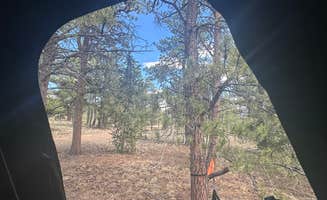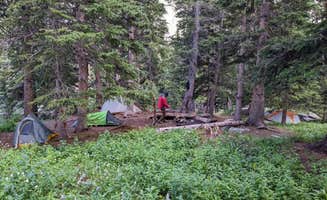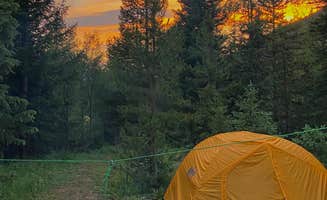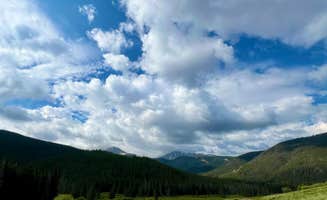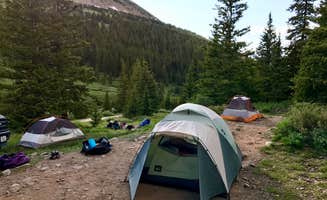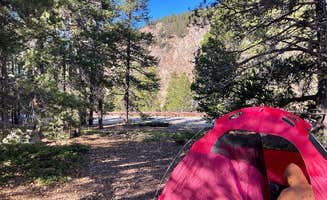Primitive camping near Grant, Colorado occurs primarily at elevations between 8,000-11,000 feet where temperatures can drop into the 30s even during summer months. The surrounding Pike National Forest features designated dispersed camping areas that typically open by mid-May, though high-elevation sites may remain snow-covered until late June. Most sites require visitors to practice Leave No Trace principles as waste facilities are minimal throughout the region.
What to do
Hiking access to 14ers: From Grays Peak Summer Trailhead Dispersed Camping, campers can start early for summit attempts. "It was the perfect camping spot to wake up early and hike Grays & Torreys Peak!" notes Ally H. The trailhead provides immediate access to two of Colorado's most accessible 14,000-foot peaks.
Mountain biking trails: The Buffalo Creek Recreation Area offers extensive trail networks. "Great camping spot, esp. if you like mountain biking. Not whistler in terms of terrain but plenty of trails for various ability levels," writes Andrew B. The area includes routes for beginners through advanced riders.
Off-roading adventures: Forest service roads throughout the region provide technical driving opportunities. At Kirby Gulch, one camper shares, "Went up the 4x4 trail up to the salt mine at the top. If you have a vehicle with 4wd You should be fine." The interconnected network of roads ranges from moderate to challenging.
What campers like
Creek-side campsites: At Bruno Gulch Dispersed, campers value water proximity. "Spots near the stream are awesome, and plenty of great hiking trails from here/nearby," notes Allison B. These water-adjacent sites provide natural cooling and ambient sound.
Wildlife viewing: The region supports diverse wildlife populations. One visitor at Peru Creek Designated Dispersed Camping reported, "LOTS of moose droppings in the area but we never saw any. We loved our spot that had gorgeous 360 views." Moose, deer, and small mammals are common throughout the area.
Late-season access: Many sites remain accessible into fall. "We were up Sept 21 & 22 and the fall colors were GORGEOUS," reports Stacy T. about Boreas Pass. This extended season allows visitors to experience changing aspen colors while avoiding summer crowds.
What you should know
Vehicle requirements vary: Access to many primitive camping areas requires appropriate vehicles. At Chinns Lake Dispersed Camping, "You'll absolutely need a 4x4 or a high-clearance SUV to get up there. The road is rocky and steep in places, but manageable with careful driving and the right vehicle," advises Zack L.
Site availability patterns: Competition for spots follows predictable patterns. "Got here Fourth of July last year and it was paaaaaacked by Thursday. Somehow got the LAST spot at the end of the road," reports Taylor C. about Kirby Gulch. Weekday arrivals, particularly Sundays through Wednesdays, offer better site selection.
Fire restrictions: Fire regulations change seasonally and require awareness. "If you are going to be camping in BLM or Wildlife Areas please follow the restrictions and don't put others at risk with no cell phone service," cautions one camper. During dry periods, complete fire bans are common.
Tips for camping with families
Insect preparation: Bug populations vary by location and season. At Sawmill Gulch, one camper warns, "The worst part was the insect infestation which we were not prepared for. Mosquitoes and biting flies were swarming due to the surrounding beaver ponds." Sites near standing water typically have more insects.
Temperature management: Elevation creates significant temperature fluctuations. "It did get pretty cool at night, and our kids definitely let us know about it. Luckily we have extra blankets to insulate their bags... But even in July, plan for cooler night time temps and rain!" advises Charlie K. about camping at Kirby Gulch.
Creek access for children: Water features provide natural entertainment. Bruno Gulch offers creek-based recreation as "the creek is a great place for kids to splash and play," according to Chris P. Look for sites with gentler water flow and shallow edges for safer exploration.
Tips from RVers
Site size limitations: Many dispersed sites have space constraints. At Saints John Trail Roadside Campsites, the access road presents challenges as "The trail getting to the camp was moderately difficult. I took my Kia Telluride up the trail and just had to take it slow as to not bottom out of rocks." Larger vehicles should stick to established locations along main forest roads.
Location scouting: RV campers should validate site suitability before committing. "When we left Friday morning but no shortage of open sites. Will definitely be back," reports Greg about Kirby Gulch, suggesting midweek departures create opportunities. Arriving before noon increases chances of securing suitable spaces.
Road conditions: Forest Service roads deteriorate seasonally. "The road to get in there is pretty gnarly. Definitely need four-wheel-drive. Lots of rocks and deep holes and even some flooded areas," notes Chris P. about Kirby Gulch. Road conditions often worsen after rainfall, making timing critical for access.





